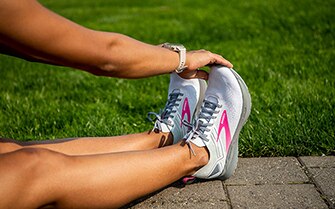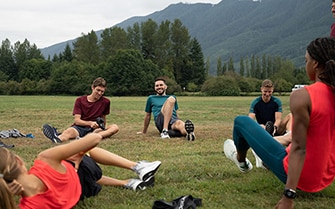What you can do to prevent running injuries

Brooks Beast Team

Brooks Beasts athletic trainer Sarah Bair shares the three categories she focuses on to help prevent injuries in runners.
Sweat the small stuff
As someone who takes care of high-level runners on a daily basis, Sarah Bair will be the first to admit it can be easy to overlook the little things.

Left to right: athletic trainer Sarah Bair, Brooks Beasts pro runner Garrett Heath, and coach Danny Mackey.
She and a group of friends recently drove 9.5 hours in one day from Seattle, Washington to Hungry Horse, Montana. To prep for the long haul, the group did some yoga the evening they arrived in preparation for their biggest hiking day in the morning.
“We woke up the next day, eager to hit the trail. Little did we know, the hike we picked was at the farthest end of the road from where we camped. We drove two hours, enjoying the slow drive and sights along the way. Once we arrived, we were so eager to hit the trail we did not stop and check in with our bodies. We didn’t do any joint mobility work, myofascial release, or muscle activation. We threw our backpacks on and went for it,” she said.
Don’t ignore your body. Stop for a few minutes to address something small and you could save yourself lots of time and pain in the future.”
About half a mile into their 16-mile day, Bair noticed her left ankle felt a little stiff. Because they were barely into the hike and had waited so long to get there, she ignored her body and kept moving. At the end of the long hike, her ankle was even more stiff and her lateral knee began to hurt.
“When we were done hiking for the day, I decided to finally address my ankle. I easily got it moving freely, but it was a little too late. My gait was altered to compensate for the knee pain. By the time I got back to Seattle, it hurt just to put a shoe on that side. I took two weeks off and sought professional treatment to reduce symptoms of what eventually became Achilles fat pad irritation, a painful swelling and diminished function of the Achilles tendon.”
In hindsight, her injury could have easily been prevented.
“I should have enjoyed more pain-free hiking on our trip and not needed all the time off. The biggest takeaway from this experience was to slow down and do the little things right. Don’t ignore your body. Stop for a few minutes to address something small and you could save yourself lots of time and pain in the future.”
The key three
To help runners avoid injury, Bair focuses on three key mechanisms: soft tissue elasticity, joint mobility and muscle activation.

“I like to think that these three things go hand in hand to get the most out of your body and to be a functional runner. Without one, the other two categories don’t work as efficiently. When they do come together in harmony, you are set up to have better injury prevention success on your run.”
Explore Bair’s three focus categories below to understand what you can do to prevent running injuries.
Soft tissue elasticity
When you increase soft tissue elasticity, which is a muscle’s ability to reach its full range of motion without restriction, you can improve muscle flexibility.
We all know that person who can bend over and put their palms on the floor, while others may barely be able to reach past their knees. You might think the answer to this problem is to spend more time stretching. While stretching is one way to increase muscle elasticity, it is not the only solution.

By increasing blood flow to a muscle through self-myofascial release, such as foam rolling, you are able to increase muscle temperature, in turn, increasing tissue elasticity.
Takeaway: To improve soft tissue elasticity, spend a short time foam rolling major muscle groups before a run.
Joint mobility
Joint mobility is the range of movement unrestricted by surrounding ligaments, tendons and muscles that occurs where two bones meet.
Restriction of movement in a joint can cause muscles and other joints to work on overdrive, possibly leading to injury.
We are all built differently, and it is important to remember that one person’s mobility doesn’t have to match yours.

A good way to check your own mobility is to compare one side to the other. For example, if you flex both of your feet towards your body and one comes closer than the other, you might have restriction in that ankle joint.
Takeaway: To improve joint mobility, spend time increasing soft tissue elasticity surrounding a joint, then actively go through the natural movement patterns of that joint. Try ankle pumps, knee drives or leg swings.
Muscle activation
The recruitment of a targeted muscle group to function during motion is called muscle activation.
Running requires lots of different muscles to work together through patterns of shortening and lengthening. If one of these muscles isn’t working in the right pattern, it can cause a rift in the chain, leading to an uneven gait pattern and potentially injury.

We have all seen the runner or been the runner who takes a little punch to their glute trying to wake it up before a run. While this might feel like a wake-up call, the best way to engage muscles is through dynamic or active-resisted movement.
Takeaway: If you want to increase muscle activation, you need to increase tissue elasticity and improve joint mobility first. Then you can get your muscles fired with dynamic drills such as high knees and butt kicks or resisted drills like lateral band walks or clamshells.
